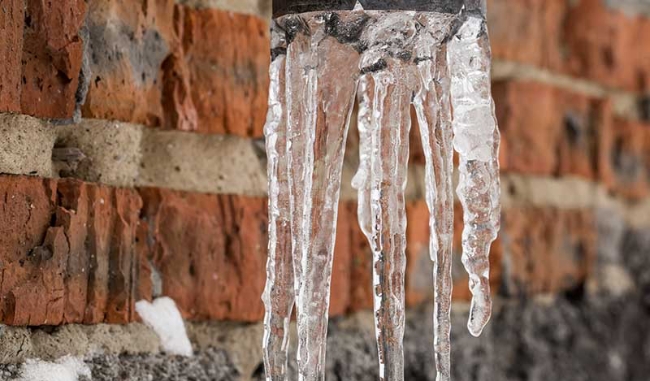We have stumbled upon this great article relating to Winter Plumbing Precautions: Preventing Frozen Pipes directly below on the web and concluded it made perfect sense to share it with you over here.

Winter can wreak havoc on your pipes, particularly by freezing pipelines. Right here's exactly how to avoid it from occurring and what to do if it does.
Intro
As temperature levels decrease, the threat of frozen pipes rises, potentially resulting in pricey fixings and water damages. Understanding just how to stop frozen pipelines is important for home owners in cold climates.
Avoidance Tips
Shielding at risk pipelines
Cover pipelines in insulation sleeves or use warmth tape to safeguard them from freezing temperature levels. Concentrate on pipes in unheated or outside locations of the home.
Home heating strategies
Maintain interior areas sufficiently heated, especially locations with plumbing. Open up cupboard doors to enable cozy air to circulate around pipes under sinks.
Exactly how to identify icy pipelines
Look for lowered water flow from taps, uncommon odors or noises from pipelines, and noticeable frost on exposed pipes.
Long-Term Solutions
Structural modifications
Take into consideration rerouting pipelines far from exterior wall surfaces or unheated locations. Add additional insulation to attic rooms, cellars, and crawl spaces.
Upgrading insulation
Invest in high-grade insulation for pipes, attics, and walls. Appropriate insulation aids preserve consistent temperatures and lowers the danger of frozen pipelines.
Protecting Outside Pipes
Yard pipes and outside faucets
Detach and drain garden hose pipes prior to winter season. Mount frost-proof faucets or cover outside taps with shielded caps.
Comprehending Icy Pipes
What creates pipes to ice up?
Pipes ice up when subjected to temperatures listed below 32 ° F (0 ° C) for expanded durations. As water inside the pipes ices up, it broadens, taxing the pipeline walls and potentially creating them to break.
Dangers and problems
Icy pipelines can bring about water system disruptions, property damages, and costly fixings. Ruptured pipelines can flood homes and create extensive structural damages.
Indications of Frozen Water Lines
Determining frozen pipes early can avoid them from rupturing.
What to Do If Your Pipelines Freeze
Immediate actions to take
If you presume frozen pipes, keep taps open to alleviate pressure as the ice melts. Make use of a hairdryer or towels taken in hot water to thaw pipelines slowly.
Final thought
Preventing frozen pipes calls for proactive actions and quick responses. By understanding the reasons, indications, and preventive measures, home owners can shield their pipes during cold weather.
6 Proven Ways to Prevent Frozen Pipes and Protect Your Home
Disconnect and Drain Garden Hoses
Before winter arrives, start by disconnecting your garden hoses and draining any remaining water. Close the shut-off valves that supply outdoor hose bibs and leave the outdoor faucet open to allow any residual water to drain. For extra protection, consider using faucet covers throughout the colder months. It’s also important to drain water from any sprinkler supply lines following the manufacturer’s directions.
Insulate Exposed Pipes
Insulating your pipes is an effective way to prevent freezing. Pipe insulation is readily available at home improvement stores and is relatively inexpensive. Pay close attention to pipes in unheated areas such as the attic, basement, crawl spaces, or garage. Apply foam insulation generously to create a buffer against the cold. You can also wrap your pipes in heat tape or thermostat-controlled heat cables for added warmth.
Seal Air Leaks
Inspect your home for any cracks or openings that could let in cold air. Seal any holes around the piping in interior or exterior walls, as well as the sill plates where your home rests on its foundation. Additionally, make sure to keep your garage door closed unless you’re entering or exiting. Leaving it open creates a significant air leak that can lead to frozen pipes.
Allow Warm Air Circulation
During cold snaps, it’s essential to allow warm air to circulate evenly throughout your home. Leave interior doors ajar to promote better airflow. Open kitchen and bathroom cabinets to help distribute heat consistently around the rooms. If you have small children or pets, be sure to remove any household chemicals or potentially harmful cleaners from open cabinets for safety.
Let Faucets Drip
A small trickle of water can make a big difference in preventing ice formation inside your pipes. When temperatures drop significantly, start a drip of water from all faucets served by exposed pipes. This continuous flow helps prevent the water from freezing. Additionally, running a few faucets slightly can relieve pressure inside the pipes, reducing the chances of a rupture if the water inside does freeze.
https://choateshvac.com/6-proven-ways-to-prevent-frozen-pipes-and-protect-your-home/

As a fervent person who reads about How to Prevent Your Pipes From Freezing, I thought sharing that article was beneficial. Sharing is caring. Helping people is fun. We love your readership.
Recurring Service Plans